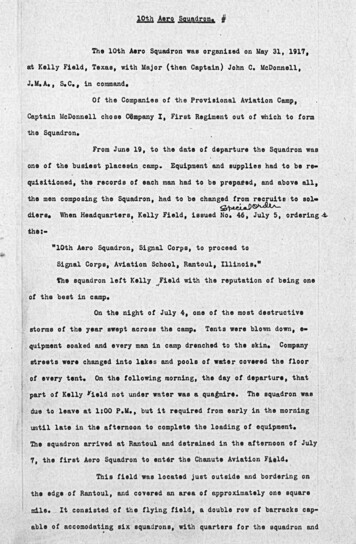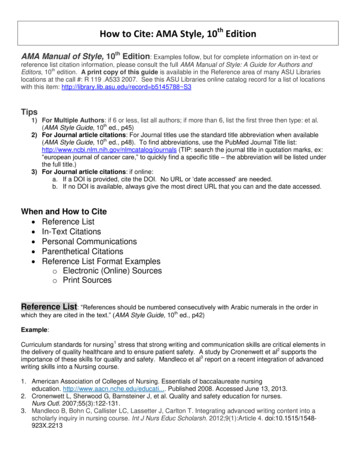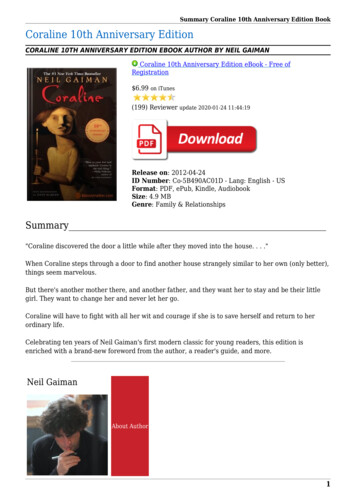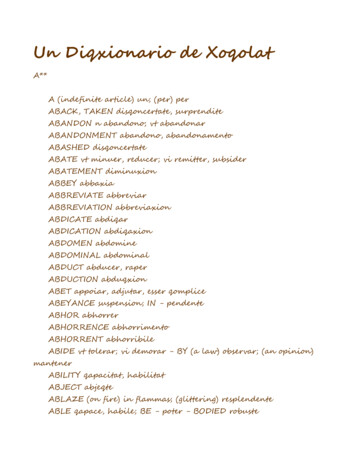
Transcription
10th Aetq SaHadron,IIThe 10th Aero . Squadron was organized on May 31, 1917 1at Kelly Field, Texas, with Major (then Captain) JohnJ.M.A.,s.c.,c.McDonnell,in command.-Ofthe Companies of the Provisional Aviation Camp,Captain McDonnell chose C6mpany I, First Regiment out of which to formithe Squadron.From June 19, to the date of departure the Squadron wasone ot the busiest place in camp.Equipment and supplies had to be re .quieitioned, the records of each man had to be prepa ed, and above all 1 the men composing the Squadron, had to be changed from recruita to sol .g, U·O diers. When Headquarters, Kelly Field, issued No. 46, July S, ordering4 the:-,,"10th Aero Squadron, Signal Corps, to proceed toSignal Corps; Aviation School, Rantoul, Illinois." fhe squadron le!t Kellyot the beatField with the reputation of being one,./in camp.On th night of July4, one of the most destructive.storms of the year swept across the camp.Tents were blown down, Jquipment soaked and every man in camp drenched to the skin.Companystreets were changed ·into lakes and pools of water cov d the floor. .of every tent.On the following morning, the day of departure, thatIpart of Kelly 1eld not under water was a quatndre.due to leave at l:OOP.u.,The squadron waebut it required from early in the morninguntil late in the afternoon to complete the loading of equipment.The squadron arrived at . Rantoul and detrained in the afternoon of July7, the first Aero Squadron to ent'r the Chanute Aviation F&ild.This tield wae located just outside and bordering onth edge -of Rantoul, and covered an area of approximately one squaremile.It consisted of the flying field, a double 1 ow ot bar.racks cap-able of accomodating eix 1quadron1, w1 th quart era for the squadron and .'
'·- 2 -field staff officers just north ot the barracks, and separated from themby a large modern hoepital.The hangarser'jlocated between the yingfield and the: barracks, large wooden structures approximately two hundredfeet long and fifty feet wide, capable of holding from six to eight/large Curtiss JN - 4 flying machines1-They extended from end to end ofthe field, parallel to the barracks, twelve in all.wasTho field/still under coaatruction, and it was not untilseveral weeks ·later1 upon the completion of the machine ship and the in stallation of the lathes and drill presses,that the first whe,ls wereturned which signified the beginning of Chanute Field as an aviationThe men of the Squadron were assigned to the mach-instruction field.ine shop for motor repair and testing, carburetor and magneto repair ·end adjustment, and trouble shooting.Late in July and early in Aui-ust, the assembly and erection and repair shop was organized to assem.ble the 'planes which began to arrive almost daily.On July 26, the first Cadet Detachment arrived to undergoflying instruction.flying training.The first week in August marked the real start ofAbout thistime there were twenty-five machines on thefield and about fifty students, most ot whom had never been up in a·machine.It was not long before motors and machines were turned overto the Engineering Dept., tor every kind of repair.This ·necessitated -:'·. the re-organization ot the Repair Dept., separate departments soon.brancaed out, wing repair, fuselager pair 1and motor installatiollftWith the inetallation ot band saws and wood-working machinery, 'planeswere almost built completely on the field.The arrival of the 38th and 39th Aero Squadrons, duringthe latter part of August, formeda welcomeaddition to the fore thenat Chanute Fi eld; aa the rapidly expanding field increased the workproportionately, thia increase in the number of men at the stattionfurther increased the flying time so that during September there wee llO at the Cade·t Detachment.On September 28, 1917, th1 Squadron lost its commanding
.officer, Major McDonnell, having received orders to proceed to Self ridge Field, at Mt. Clemons, Michigan, to take up more important duti After the intense heat, leaky tents and uncomfortable cotsof Kelly Jield, the electric lighted, steam heated barracks at Rantoul,'with hot and cold water showera, spring beds wi·t h mattresses and feather pillows, were much appreciated by the min.1h peopleornearbytowns built up a strong friendship between themselves and the men ofChanute Fielde· It was a day of great celebration when Headquarters, Chan Iute Field, ordered the Squadron to prepa* for service overseas, onOctober 25, 1917.While this order intended that every man of theSquadron should leave with the organization, it was discovered on check ing up that manyor · themheld positions of such responsibility at thefield, that it was decided to transfer these men out of the Squadron.The next week was spent in packing and marking all the additional equip ment of the new men who were transferred into the Squadron.When lstLieut. Gilmore L . Tilbrook, s.c.,(who had been appointed in command when!kl.jar McDonnell,s.c.,was relieied) rece.ived Special Order No. 63, Head quarters, SCAS. 1 Chanute Field 1 to entrain at the Rantoul siding at10:00 P.M. it was not more than an hour after the train drew into the.;siding, that the Squadron was on its way eastward to the Atlanticcoast. ·On November 3 1 the Squadron arrived at the Concent4at1onCamp at Garden City, Long Island, New York, to await embarkation orders.-'lbe next three weeks was a long, tedious wait to the man, but this timewas completely occupied with drillmorning and afternoon, instructionsin pitching shelter tents, and the correct method of making up a "pack" Equipment inspections were regular and frequent and any deficienciesor unserviceable articles o! equipment were immediately drawn or re placed ,so the Squadron lett the Stat.ea with the finest and best poeai bl equipment,On the evening ot December 3, 1917, the Headquarters,. .s.c.,
·4·'Concentration Camp, Garden City, notified SquadronHeadquarters , topre-pare to move in six hours, and late that night the Squadron started onthe journey to the port of embarkation. Six o'clock the following morn ing the Squadron 9etrained at the Philadelphia Nayy Yard and a few hourslater were aboard thes.s.Nort And,During the early morning ofDecember 5, the Northland steamed down the bay and out into the Atlantic orrOn the morning of the Sth, anchor was droppedNova Scotia.the town ot Halifax,Halifax, usually one of the busiest and most prosperoustowns in Canada, presented a mournful sight after the explosion ofthousands of tons of high explosive on board a munition ship.As the re ports of the disaster were carried aboard the ship by the officers and ·.sailors on shore leave, it was decided to collect a fund to alleviatethe sufferings of the inhabitant,, the totalorwhich amounted to sever-at thousand dollars from the Northland,, The Mayor of the town in a message a few days later expressed his thanks to the squadron.On-the morning ofstream and into place inthe the 15th, the Northland swung out into theconvoy, consisting of nine ships in all.Christmas day the skeleton work of the Nww Brighton Light of Liverpool,England,appea edover the bow and by noon the Northland dropped anchorin the river Mersey.The troops were quickly landed that night, andas . the landing stage was but a short distance from the trains, littletime was lost in transferring the baggage from the floats to the small,square , box-like Continental freight cars,.plated shortly before mid-night.th loading of which was · com-The morning of December 26, the train-steamed into Southampton,. the port ot embarkation to France.\Late inthe afternoon the men were marched aboard the Marguerite for transport across the channel.The Marguerite was an ancient channel boat of the sidewheeler type.In design and size it resembled Fulton's first attemptLlto propel boats by steam.The name plate in the saloon had long sincebeen worn smooth and the dateorlaunching was obliterated but uponcs
5 -'.close inspection the figures l, 6, 4, and 8 were discernible and it wasunanimously agreed that this must be the date of her first trip acrossthe channel.almost entirely of wood, every joint and beam ga.vel\ ade,out a mournfuls ueak, -as her engines wheexed and her paddles dippedin the wate:;c he slowly wheeled about and pointed her nose towards thecoast of France.The morni ng of December 27, found thebumping against thebreak aterwharres of the FrenchM gu e ri t e.nd slowly wi nding her way up to thes eapo rLe Havr e.The troops disembark ed about ·noon, and marched up hill t o,(lest Camp, about ei ght mile s fro m theThe Rest Camp consi sted of about ado z nrows of small con ical tents about tv.'el ve feet in diameter, to which from eight to tenmen were assigned, the men sleeping on the ground.The Ca.mp was lo cated on the heights that overlooked the city and exposed on all sides rato the penetrating coldAtlantic.winds thatswept across the heights from theAs the sides of the tents often lacked from four. to six in ches of touching the ground, the snow,whic w sthen six inches deep,blew in under the tant flaps, spreading a layer of snow over everyoneduring the night.It waa with little regret the men left Rest Camp No. l atLe Havre, and marched down to the Railway terminal to entrain once more.''Nhen the Squadrons arrived at the terminal they experienced for thefirst time, travel "a la guerre.The coaches were plainly marked "Bcheiaux'' or "40 hommes" 1 the sidesorthe car were without -ndows but;with large sliding doors on each side, furnishing ample ventilation andlight; especially ventilation, with the temperature at about 20 below.cThe floor of the coach . was covered withet awwith a lingering odor(that suggested the late departure ot the "8 chevaux".Fourr squadswere aseiened to each car, about thirty men in each one eommodatiqns were again a problem.Sleeping ac-The man who had figured tt40 Che-vaux" per car had evidently reasoned that the "hommes" like the "chovaux" ''ould eleep standing up.Standing up, thirty Yank "hommes"
- 6 -made a close fit in this French coach, but finding room to sleep thirty.we.a something else again, so much eo, that the individ Yank "hommes"ue.l ndcollective ideas of the carload, failed to find the answef! dnr ine the following two nights.At Daybreak on January lst, the men detrained, and marchedoff through the little twwn of St. Maixent to the large French armory,Canclaux Barracks.The Squadron spent almost the entire month of Jan-uary at this place, and except for the time when the Squadron was notdrilling, liberty passescwere allowed to the men to visit the to'n andget their first look at France.The rations though were somewhatscarce, consisting of "corned ,Nilly" three times a day, occasionallysome jam, and no "seconds".On Jan. 26, 1918, the Squadron once again entrained andstarted under way to "America's largest aviation camp in France" atIeaoudun, Indre, France 1 erriving eh the afternoon of January 27. which.marked the date when the Squadron was once more to start in service,as partorthe organiaation to maintain an aviation center, almost threemonths after leaving its la1t aviation station - Chanute Field, Rantoul,Illinois.As the Squadron had not had any previous experience on thesmall, fast chasee French 'planes, the mechanics were schooled in thecaae and repair or these new flying ships during the following two or.three weeks.The new po st we.a known as the Third Aviation Instruction·Cent6r 1 consisting ot (at that time) seven fields, each field trainingth pilotsin some one particuler phase of the complete training On February 7, i918 1 the Squadron left the l ilin Field andproceeded to Field 7, which was located about fifteen kilometers fromthe Main Camp.The unit remained at this field, acquiring turther'.'.knowledge and experience on the care and maintenance of the 'plane s ·. ,,On February 20. 1918 1 Headquarters, 3rd A.I.C. issued.a Memo directing the Tenth Aero Squadron to proceed to a location aboutused in training. ·
- 7 -ten kilometers from Field 7, to start the new combat field of the Cen Iter,Ft4lda.a,On the day the Squadron arrived at Fieldthe Field con aisted of two barracks two partially erected barracks and, due to tht ·&,,(. "'1 days, a hu mud-hole.constant drizzle of severalnext two or three weeks, shouldered the arms'ortheSquadro fortheTheAviatio h pickand shovel, ruid proceeded to change the mud hole, known officially asFielda,into a place to live and an aviation training field.Theywere aeeieted in this by the 644th Aero Squadron, who arrived severalweeks after the arrival of the Tenth Squadron.The partially completedbarracks were finished, new ones erected and completed·, latrines sunk,the administration building being the last to be finished.During the latter part of the month the first large canvashangar arrived from the Main Field, and work was immediatelj commencedon its erectionwhich was soon completed, followed closely by two otherseo that when the first 1 planes arrived, about the second week of March,,.1918 1 they weee run into the hangars and the Field was ready to commencetraining.Captain James A Buchanan, A.S., was the first commanding officer of the field 1 assigned February 21, 1918.The early weeks ofMarch, were spent in the organization of the Field Training Headquart-.ere, and on March 13, 1918 1 the first 'plane "took oft", No. 321, type.,27 Nieup·ort, marking the beginning of flying instruction at Field BeThe !ollowing months witnessed the gradual expansion otthe FieldtSeveral more hangars weing erected and more 'planes added ,'Ito th1 Field.The worko th crew men, consisted in the care ot the'planes, keepingthem tuned up and th making of minor repairs.or repairswer Mal sent to the Main Camp, but as the number of machinesincreased, it was found more efficient to make all repairs at Fielda,Ias it required less time and economized transportation.Thia nec es-iated th organization ot major repair hangar, which was put in
;with large sliding doors on each side, furnishing ample ventilation and light; especially ventilation, with the temperature at about 20 below. The floor of the coach . was covered with et aw with a lingering odor that suggested the late departure ot the "8 chevaux". ( Fourr squads











